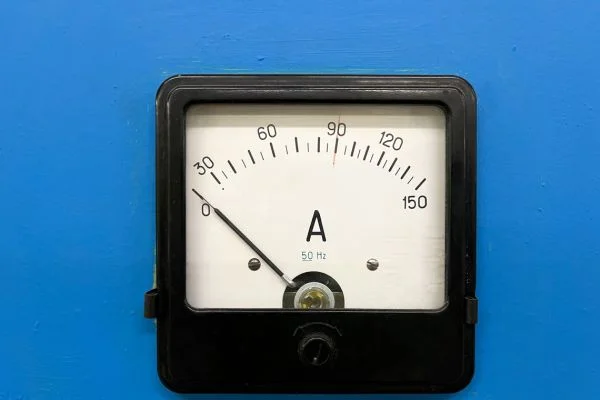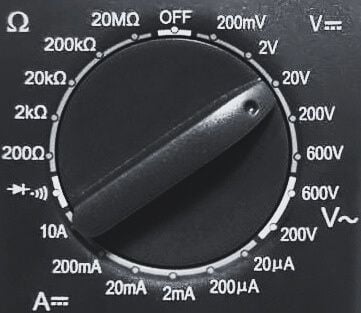Multimeters are used to measure current, voltage, and all kinds of electrical variables. To measure amps in a circuit, however, requires more care and attention. Because it’s actually the amperage that gives you an electrical shock. The amperage of any circuit depends upon its voltage sources. There are two types of voltages: AC and DC. So, there is a different procedure to measure current in DC and AC circuits. So, how to measure amps in a circuit.
What are the Amps?
Amp is basically a unit of current and is commonly known as ampere. The amperage of any circuit shows the power or capacity of any electrical equipment.

Now, you know the importance of amps. So, now you’re ready to measure amps in any circuit. Read on how to test an electric fence?
You can measure current with both multimeters and clamp meters. With a digital circuit, you can measure current in both AC and DC circuits, but the only thing you need to know is whether the circuit is energized or dead. I have also made an in-depth comparison between clamp meters and multimeters to help you understand their workings.
There are two ways to measure current in any circuit:
Direct measurement:
Direct measurement measures current at the point where it enters the circuit. For this purpose, you can use a multimeter or clamp meter.
Indirect measurement:
Indirect measurement measures current at some point outside of the circuit. This can be done by using an ammeter or voltmeter connected to two different points in the circuit.
Tools required to measure current
- Screw Driver
- Multimeter or Clamp meter
- Insulated Gloves
Read more about How to check amps in 220V to 240V circuit?
Step by step guide to measure AC/DC current in a circuit
As a first step, you should know what the amp rating of the circuit is. Now you have roughly an idea of the value to be measured. Now you have to select the multimeter. A standard multimeter, can measure current up to 10A (A=amps). So, if you want to measure current in AC circuits above 10 amps, then you need a clamp meter. Using a clamp meter can provide accurate and safe current measurements, especially in higher amp applications. Remember to consider your specific needs and requirements when choosing the right tool for the job.
How to Measure Amps (current) using Multimeter?
How to measure amps in a circuit? In AC circuits you can measure current only in series with a multimeter.
To measure AC amps with a multimeter, follow these steps:
- Select the Correct Multimeter Setting: Turn the dial to the AC current (A~) setting.
- Connect the Test Leads: Insert the black lead into the COM port and the red lead into the port marked with an “A”.
- Break the Circuit: Turn off power to the circuit, then open it to allow current measurement.
- Place the Multimeter in Series: Connect the test leads to the circuit so that the current flows through the multimeter.
- Turn on the Power: Restore power and read the current measurement on the multimeter display.
- Record and Disconnect: Turn off the power again, remove the multimeter, and reconnect the circuit.
Always ensure to observe safety precautions and manufacturer guidelines when measuring electrical currents.

fig. 1
Measuring DC amps (current) in a circuit
Measuring DC amps in any circuit is almost similar to AC amp measurement. But in DC measurements you have to attach your multimeter in series only on Positive voltage lead. Because the current in DC circuits flows mostly through positive leads and the negative lead is mostly used as common for inner PCB earthing.
So, if you want to avoid any false reading or want to avoid any ghost voltages then choosing the positive voltage lead will be a wise option. Now all you have to do is choose the right clamp meter. I have also made a list of TOP CLAMP MULTIMETERS FOR ELECTRICIANS, which may suit your requirements.
Read more about: Multimeter symbols meanings
How to measure current in a circuit with a clamp multimeter?
Next to the digital multimeter is the clamp meter which simplifies measuring current. No matter which circuit it is, AC or DC, it’s possible to measure the current without opening the connection.
A clamp meter is basically a multimeter with a clamp type jaw coil.
Step by Step Guide
- You can clamp any wire with this opening jaw. This coil acts as a secondary coil, and the current-carrying conductor or cable acts as the primary coil.
- To measure current in a circuit all you have to do is select the amp (A~) option and clamp the conductor. But you can clamp only a single insulated or naked cable at a time.
- If you have an insulated cable with live and neutral wire then strip the insulation to clamp on a single wire.
- After this, the clamp meter controller reads and shows the current flow through the cable on the display.
Using a clamp meter can be a convenient and efficient way to measure current in various electrical systems. If you’re considering using a clamp meter or interested in learning more about its usage and benefits. Hope you know how to measure amps in a circuit.
Read more about: Multimeter vs Clamp meter
Reasons to Measure Amps in a Circuit
Measuring the current (amps) in a circuit is a fundamental practice in electronics and electrical engineering. This procedure provides crucial insights into the operation, performance, and safety of electrical systems. Here are some key reasons to measure amps in a circuit, organized under distinct headings for clarity.
Ensuring Proper Functionality
Verifying Design Specifications
Every electrical circuit is designed to operate within specific parameters. Measuring the current helps verify that the circuit is functioning according to its design specifications. If the current is too high or too low, it can indicate a potential issue that needs addressing. Ensuring that the current aligns with the design expectations can prevent premature failure of components and maintain system reliability.
Troubleshooting Issues
When a circuit is not operating correctly, measuring the current can help identify the problem. For example, if an electrical device is not working as expected, checking the current can reveal if the issue is due to a lack of power or an excess current draw. This information is critical in diagnosing and fixing faults, whether it’s a short circuit, an open circuit, or a component failure.
Enhancing Safety
Preventing Overloads
One of the most important reasons to measure amps in a circuit is to prevent overloads. Excessive current can cause overheating, potentially leading to fires or damage to electrical components. By regularly measuring the current, technicians can ensure that the circuit is operating within safe limits, thus preventing hazardous conditions.
Protecting Equipment
Electrical devices are designed to operate within certain current limits. Exceeding these limits can cause damage to sensitive components, reducing the lifespan of the equipment. Measuring the current ensures that each component is receiving the appropriate amount of power, which helps in protecting and preserving expensive and sensitive equipment.
Improving Efficiency
Optimizing Power Usage
In both residential and industrial settings, optimizing power usage is essential for reducing energy costs. By measuring the current in a circuit, one can determine if the system is using power efficiently. Identifying areas where current is unnecessarily high can lead to adjustments that improve the overall energy efficiency of the system, thereby reducing electricity bills and minimizing environmental impact.

Identifying Power Loss
Power loss in a circuit can result from various factors such as resistance in wires, faulty components, or poor connections. Measuring the current can help identify these losses. For instance, if the current measured at the power source is significantly higher than the current at the load, it indicates power loss along the circuit. Identifying and rectifying these losses can improve the efficiency and performance of the electrical system.
Ensuring Compliance
Adhering to Standards
Electrical systems must comply with various local, national, and international standards and regulations. These standards often specify maximum current limits to ensure safety and efficiency. Regularly measuring the current in a circuit helps ensure compliance with these standards, avoiding legal and regulatory issues that could arise from non-compliance.
Meeting Warranty Requirements
Many electrical devices and systems come with warranties that are contingent on proper usage, which includes operating within specified current limits. Measuring the current helps ensure that the equipment is used correctly, maintaining the validity of warranties. This can be particularly important for costly industrial equipment where warranty claims can provide significant financial relief in case of failures.
Enhancing System Performance
Balancing Loads
In complex electrical systems, especially in industrial or commercial settings, balancing loads is crucial for optimal performance. Uneven distribution of current can lead to inefficient operation and potential overloading of certain components. Measuring amps in various parts of the circuit allows for proper load balancing, ensuring each part of the system operates efficiently and safely.
Predictive Maintenance
Predictive maintenance relies on monitoring the condition of equipment to predict failures before they occur. Measuring current is a key part of this process. By regularly checking the current in a circuit, technicians can detect unusual patterns or deviations from the norm, indicating potential issues. Addressing these issues proactively can prevent unexpected downtime and extend the lifespan of the equipment.
Conclusion (How to measure amps in a circuit)
Most people do a very common mistake of measuring current like other electrical variables. You may even lose your life by making this mistake. So, if you want to do it on your own then you must have to choose the right multimeter and know how to measure current in a circuit. Now you know how to measure amps in a circuit.
If you’re still with me, then you might have a clear idea about how to measure voltage properly without risking your life. Now, all you have to do is choose the right multimeter (see the best multimeters for home use). Furthermore, if you’re still confused, then it’s better to call an electrician for this purpose. They can ensure accurate measurements and provide professional assistance.
FAQs-Frequently Asked Questions
How to measure current in an electrical circuit without power?
Current is basically the flow of electron charges in the electrical circuit. If the circuit is off then you can not measure the amps because the net result will be zero and your multimeter will show zero value.
Compared to measuring voltage, how do you measure current?
While measuring voltage, you have to select the AC/DC voltage range and use the “V” and “Com” jacks for test lead insertion. Furthermore, for voltage measurement, you have to connect the positive and negative test leads in parallel. But in current measurement, you have to connect the DMM in series with the load; otherwise, you will see a voltage drop. Another difference between voltage and current measurement is the test lead jacks. In current measurement, you have to insert test leads in the A~ and Com jacks.
Read more about:Best multimeter for milli volts testing
Which measuring device is best for electrical components?
You can either use a digital multimeter, an analog multimeter, ampere meter, or a clamp meter for measuring amps in any electrical system. All you have to do is to choose the right range. The best tool to measure voltage is a digital multimeter, but to measure current, a clamp meter is the best option. Because with clamp meters, you can measure current up to high ranges.

